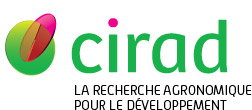Bloch Melody, Helmick Erika, Pilet Fabian, Bahder Brian W..
2024. Developing a new molecular assay for detection and differentiation of palm lethal decline phytoplasmas in Africa.
|
Version publiée
- Anglais
Accès réservé aux personnels Cirad Utilisation soumise à autorisation de l'auteur ou du Cirad. Bloch et al 2024.pdf Télécharger (345kB) | Demander une copie |
Résumé : Palm lethal decline phytoplasmas have caused severe losses of coconut palms (Cocos nucifera) in various parts of Africa. These diseases are caused by multiple species of phytoplasma, and the insect vector species have not yet been confirmed. Efficient monitoring of these phytoplasmas is essential for understanding disease epidemiology, and for creating and implementing effective management strategies. Current methods used to detect and identify palm lethal decline phytoplasmas include standard or nested PCR, followed by restriction fragment length polymorphism (RFLP) or sequencing. There have also been quantitative PCR (qPCR) assays using universal primers, which can more rapidly detect and quantify phytoplasmas without needing to perform post-PCR steps, such as visualizing the product on a gel. These techniques are not convenient for widescale, rapid detection and identification of phytoplasmas within multiple palm or insect samples. In this study a qPCR assay with high-resolution melt curve analysis (HRMA) was developed for the detection of the causal agents of palm lethal decline in Africa, including Candidatus Phytoplasma cocostanzaniae, Candidatus Phytoplasma palmicola, and a new phytoplasma species that is yet to be described. This assay successfully amplified each species of phytoplasma and yielded unique melt temperature ranges for each species. Therefore, it can be used to detect and simultaneously differentiate between the three species of phytoplasma. This can provide a useful tool for fast and efficient monitoring of multiple phytoplasma species in palms and may also aid in detection of phytoplasmas within putative vector hosts.
Auteurs et affiliations
- Bloch Melody, University of Florida (USA)
- Helmick Erika, University of Florida (USA)
-
Pilet Fabian, CIRAD-BIOS-UMR PHIM (REU)
 ORCID: 0000-0003-0079-216X
ORCID: 0000-0003-0079-216X
- Bahder Brian W., University of Florida (USA)
Source : Cirad-Agritrop (https://agritrop.cirad.fr/613083/)
[ Page générée et mise en cache le 2025-09-28 ]




